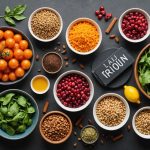Understanding Fibromyalgia and Its Symptoms
Fibromyalgia is a complex, chronic disorder characterised by widespread pain and tenderness. Affecting approximately 2-4% of the population, it is more prevalent among women. While the exact cause remains elusive, various factors such as genetics, infections, and physical or psychological trauma might trigger or worsen symptoms.
Common Symptoms Experienced
Individuals with fibromyalgia often endure a multitude of symptoms. These include chronic pain throughout the body, often described as a constant dull ache, lasting for over three months. Fatigue is another prevalent symptom, even after an extended sleep. Unfortunately, many people with fibromyalgia experience sleep disturbances, affecting their overall rest and recovery. Cognitive difficulties, colloquially known as “fibro fog”, impair focus and memory, further complicating daily life tasks.
Topic to read : Crafting Your Unique Dietary Blueprint: Boost Your Iron Levels Naturally
The Impact on Daily Life
The persistent nature of fibromyalgia symptoms can significantly hinder day-to-day activities. Simple tasks can become formidable challenges, impacting work performance and diminishing quality of life. Social interactions might also suffer, as the ongoing pain and fatigue can limit social engagement. Effective chronic pain management is crucial, involving a combination of medication, therapy, and lifestyle adjustments. Understanding fibromyalgia better is essential for developing coping strategies, offering those affected hope for improved management and relief.
Lifestyle Changes for Fibromyalgia Relief
Finding relief from fibromyalgia often starts with lifestyle modifications. Establishing a consistent daily routine can alleviate symptoms by providing structure and predictability, which are crucial in managing the pain and stress associated with this condition. Start by planning your day with regular times for meals, exercise, and relaxation.
Additional reading : Unlocking the Power of Omega-3: Discover the Health Benefits of Incorporating These Essential Fatty Acids into Your Diet!
Improving sleep quality is another pivotal modification. Create an environment conducive to rest; consider a dark, quiet room and a comfortable mattress. Avoid screens before bedtime to help regulate your sleep cycle. These small changes can significantly affect the management of fibromyalgia symptoms.
Effective pain reduction strategies involve stress management techniques. Regular mindfulness practices, such as meditation or deep-breathing exercises, can help keep stress at bay. Identifying and reducing triggers, such as certain foods or stressors, can also play a significant role in your daily routine management.
Maintaining a balanced lifestyle that prioritises self-care will ensure that you are proactive in addressing fibromyalgia. This comprehensive approach provides a foundation for other medical treatments to be more effective. Through commitment to routine, quality sleep enhancements, and stress reduction strategies, patients often find a notable improvement in their quality of life.
Exercise and Physical Activity
Engaging in exercise for fibromyalgia can be daunting, yet it’s a pivotal step towards managing symptoms and improving quality of life. It’s essential to choose the right types of exercise and tailor them to individual needs.
Types of Exercise
For those with fibromyalgia, exploring gentle workouts is advisable. Low-impact exercises like stretching, walking, or yoga can significantly assist in easing muscle pain while enhancing flexibility. Aquatic exercises are particularly beneficial, as the water supports the body, reducing stress on joints. These workouts are not only effective but can be adapted to various intensity levels, providing a customised experience.
Creating an Exercise Routine
Developing a sustainable and enjoyable routine involves identifying activities that you find pleasurable. Balance is key—alternate between different exercise types to avoid overuse of any one muscle group. Incorporate benefits of physical activity like improved mood and sleep as motivation. Consultation with a healthcare provider, such as a physiotherapist, can help tailor a program specific to your needs and constraints.
Incorporating Movement into Daily Life
Incorporating movement doesn’t always necessitate a structured routine. Simple changes such as taking the stairs, stretching during breaks at work, or combining chores with brief walks can seamlessly increase daily activity levels. Small, frequent movements integrated into daily tasks contribute positively to overall wellbeing and fibromyalgia management.
Dietary Modifications for Symptom Management
Exploring a tailored fibromyalgia diet can significantly aid in managing symptoms. Adopting nutritional strategies that focus on anti-inflammatory foods is essential. These foods, like turmeric and leafy greens, are known for their ability to reduce inflammation, which can often contribute to chronic pain experienced by fibromyalgia patients. Emphasising such options could lead to a noticeable decrease in symptoms.
The quality of your diet plays a crucial role in symptom management. Consuming whole grains, lean proteins, and fresh fruits can support overall health and may improve energy levels, which are frequently troublesome for those with fibromyalgia. Equally important is maintaining adequate hydration; water supports bodily functions and can help alleviate fatigue.
While choosing beneficial foods is essential, it is also important to recognise and avoid those that might exacerbate symptoms. Certain foods, like those high in preservatives, caffeine, and sugar, have the potential to trigger discomfort or increase inflammation.
By understanding the impact of specific foods, patients can make informed choices that contribute to alleviating fibromyalgia symptoms. Adapting dietary habits based on these nutritional strategies might provide a practical and feasible approach to daily symptom relief.
Mindfulness and Relaxation Techniques
Exploring methods for achieving a calm and focused state of mind can be instrumental in managing life’s pressures. The following sections delve into mindfulness practices, highlighting breathing exercises and progressive muscle relaxation to foster stress reduction.
Introduction to Mindfulness
Mindfulness involves being fully present in the moment, acknowledging thoughts and feelings without judgement. This practice enhances emotional wellbeing, making it a powerful tool for stress reduction. Incorporating simple mindfulness practices into daily routines, such as mindful eating or journaling, supports mental clarity and emotional resilience.
Breathing Exercises
Controlled breathing restores balance to the body and mind, acting as one of the easiest relaxation strategies. A basic technique is the 4-7-8 method: inhale for four seconds, hold the breath for seven, then exhale for eight. These exercises can be integrated into daily life, allowing for a swift transition from stress to calm.
Progressive Muscle Relaxation
This method involves tensing and then releasing different muscle groups, encouraging physical relaxation. Focusing on one area at a time helps identify tension patterns and is especially beneficial for those experiencing chronic pain. Consistent practice helps individuals recognise when stress manifests physically, enabling faster stress reduction.
Natural Remedies and Alternative Therapies
In recent years, natural treatments have gained traction as potential aids for various health concerns. Among these, herbal remedies are particularly popular. Supplements like Echinacea may enhance the immune system, while St. John’s Wort is often used for mild depression. However, it’s crucial to consult healthcare professionals before beginning any herbal regimen, as they may interact with medications or have side effects.
Acupuncture is another recognized alternative therapy. Originating from traditional Chinese medicine, it involves inserting thin needles at specific body points. Many find it beneficial for pain relief, with studies showing it can be effective for conditions like migraines and osteoarthritis. Yet, effectiveness can vary, and it’s essential to seek certified practitioners.
Apart from herbs and acupuncture, other alternative therapies also offer symptom relief. Techniques such as yoga and meditation not only reduce stress but can improve overall well-being. Additionally, chiropractic care can address musculoskeletal issues. These therapies are holistic, aiming to balance the body and mind. While alternative therapies can be complementary to traditional medicine, they shouldn’t replace professional medical advice. Always explore options and make informed decisions to ensure safety and effectiveness.
Success Stories and Testimonials
Within the vast landscape of fibromyalgia experiences, personal accounts play a vital role in unlocking strategies that work. By exploring real-life narratives, individuals can gain insights into effective, non-drug approaches to managing this complex condition.
Real-life Experiences
Many people living with fibromyalgia share their journeys to inspire and inform others. For instance, some have found relief through exercise regimes like yoga or tai chi, which help in reducing pain and improving flexibility. This demonstrates the significance of personalised practices.
Successful Strategies
Those managing fibromyalgia have discovered diverse techniques that cater to their unique needs. Incorporating relaxation methods such as meditation and mindfulness is often cited in personal accounts as being particularly beneficial. Developing a consistent routine that balances physical activity and rest is another frequently adopted strategy that yields positive results.
Encouragement from Shared Stories
Stories of overcoming challenges offer encouragement and motivation to others in similar situations. Hearing about paths to success reinforces the belief that managing fibromyalgia without medication is possible. Embracing these shared strategies not only empowers individuals but also fosters a community of support, proving invaluable on their health journey.











